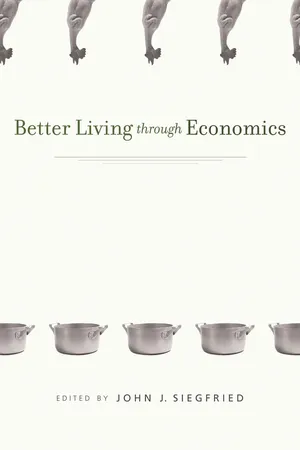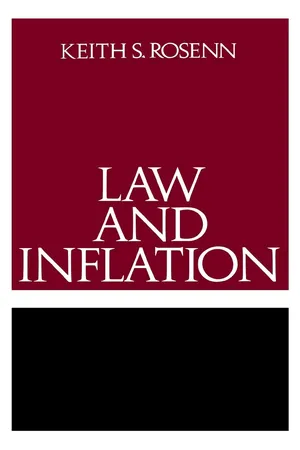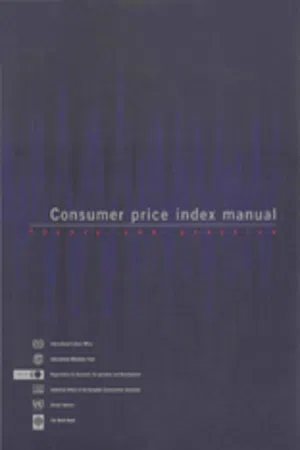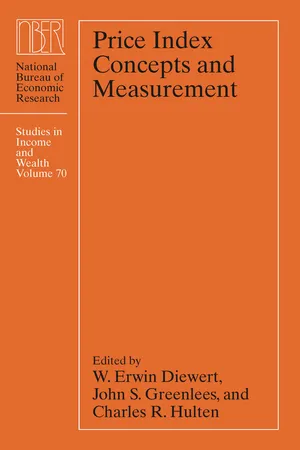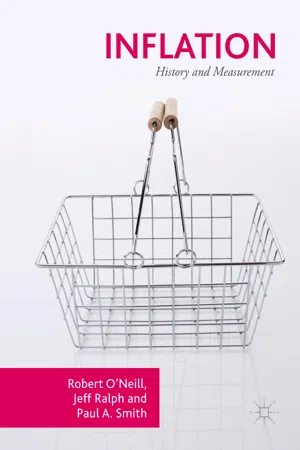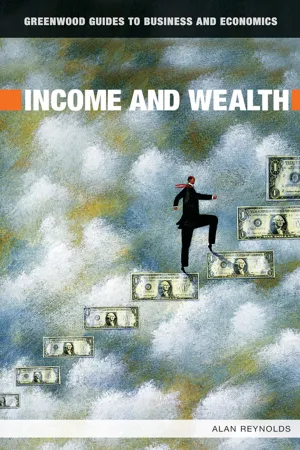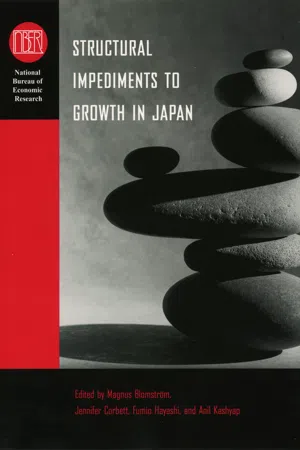Economics
Consumer Price Index
The Consumer Price Index (CPI) is a measure of the average change over time in the prices paid by urban consumers for a market basket of consumer goods and services. It is used to gauge inflation and to adjust income and cost-of-living increases for individuals. The CPI is a key indicator of economic health and is closely monitored by policymakers and economists.
Written by Perlego with AI-assistance
Related key terms
1 of 5
12 Key excerpts on "Consumer Price Index"
- eBook - PDF
- John J. Siegfried, John J. Siegfried, John J. Siegfried(Authors)
- 2010(Publication Date)
- Harvard University Press(Publisher)
Renters know how much they pay in rent. c h a p t e r t w o Better Living through Improved Price Indexes Michael J. Boskin Boskin p 64 Measuring prices, therefore, may seem simple and straightforward, but it is not. The purpose of a price index is to summarize information on the prices of multiple goods and services over time. Consumer spending accounts for about two-thirds of U.S. GDP. The Consumer Price Index (CPI) and the Personal Consumption Expenditure (PCE) deflator are designed to summarize the prices of goods purchased by consumers over time. In a hypothetical society with only one good, say, one type of food, we would not need a price index; we would just follow the price of that one good. When there are many goods and services, however, we need a method for averaging the price changes or aggregating the information on the many different prices. The rate of change of prices—inflation—is important in both macro- and microeconomics. Estimating inflation and real growth, for example, requires measures of price changes, and in a flexible, dynamic modern market economy, obtaining accurate measures is complicated. A single large superstore may contain 50,000 separately priced items. Within that individual store new items are continually introduced and old items discontinued. The quality of many items improves in some objective way— greater energy efficiency, more durability, or less maintenance, to name a few. Of course, improvements are claimed for many more items. When quality really does improve but the price stays the same, the real price has fallen. How to summarize what happened to prices in just one store over a period as short as one month is complicated, even with modern scanner technology. Doing so for the entire economy is vastly more complex. To obtain information on the average price change requires us not only to measure the prices but also to weight the various components of the index. - eBook - PDF
- Keith S. Rosenn(Author)
- 2015(Publication Date)
- University of Pennsylvania Press(Publisher)
The Consumer Price Index Consumer Price Indexes attempt to measure changes over time in the prices of equivalent goods and services that are consumed during the 21 2 2 L A W A N D I N F L A T I O N normal course of living. In most countries the Consumer Price Index is the most widely used estimation of the inflation rate. The index numbers typically reflect average annual price changes, from which are calculated the figure usually bandied about, the average annual percentage rate of change. Perhaps more relevant, however, is the year-end rate of change, the percentage change from December to December of each year, or the percentage change in the index over the most recent twelve-month period. If the inflation rate is rising, the year-end and most recent twelve-month percentages will be higher than the average annual rate. On the other hand, if the inflation rate is declining, the average annual rate will be higher. What does it mean to say that the Consumer Price Index for 1975 rose 11 percent in the United States, 15.9 percent in Great Britain, or 585.9 percent in Chile? What lies behind these figures? How are index numbers derived, and what do they purport to measure? Constructing a Consumer Price Index A Consumer Price Index is designed to measure the rate of change in prices paid by the consumer for certain goods and services. But constructing even a simple price index is no easy task. Consider the case of a primitive economy with only five commodities—bananas, coconuts, fish, grass skirts, and rum. Assume that in December of 1979 and 1980 the following price observations were recorded: Item 1979 Price 1980 Price bananas 2 4 coconuts 1 1 fish 3 5 grass skirts 8 15 rum _5 .12 Totals 19 37 With this price data, one can construct a crude price index for this economy. - eBook - PDF
- Steven A. Greenlaw, Timothy Taylor, David Shapiro(Authors)
- 2017(Publication Date)
- Openstax(Publisher)
The most commonly cited measure of inflation in the United States is the Consumer Price Index (CPI). Government statisticians at the U.S. Bureau of Labor Statistics calculate the CPI based on the prices in a fixed basket of goods and services that represents the purchases of the average family of four. In recent years, the statisticians have paid considerable attention to a subtle problem: that the change in the total cost of buying a fixed basket of goods and services over time is conceptually not quite the same as the change in the cost of living, because the cost of living represents how much it costs for a person to feel that his or her consumption provides an equal level of satisfaction or utility. To understand the distinction, imagine that over the past 10 years, the cost of purchasing a fixed basket of goods increased by 25% and your salary also increased by 25%. Has your personal standard of living held constant? If you 222 Chapter 9 | Inflation This OpenStax book is available for free at http://cnx.org/content/col12190/1.4 do not necessarily purchase an identical fixed basket of goods every year, then an inflation calculation based on the cost of a fixed basket of goods may be a misleading measure of how your cost of living has changed. Two problems arise here: substitution bias and quality/new goods bias. When the price of a good rises, consumers tend to purchase less of it and to seek out substitutes instead. Conversely, as the price of a good falls, people will tend to purchase more of it. This pattern implies that goods with generally rising prices should tend over time to become less important in the overall basket of goods used to calculate inflation, while goods with falling prices should tend to become more important. Consider, as an example, a rise in the price of peaches by $100 per pound. If consumers were utterly inflexible in their demand for peaches, this would lead to a big rise in the price of food for consumers. - Steven A. Greenlaw, Timothy Taylor, David Shapiro(Authors)
- 2017(Publication Date)
- Openstax(Publisher)
The most commonly cited measure of inflation in the United States is the Consumer Price Index (CPI). Government statisticians at the U.S. Bureau of Labor Statistics calculate the CPI based on the prices in a fixed basket of goods and services that represents the purchases of the average family of four. In recent years, the statisticians have paid considerable attention to a subtle problem: that the change in the total cost of buying a fixed basket of goods and services over time is conceptually not quite the same as the change in the cost of living, because the cost of living represents how much it costs for a person to feel that his or her consumption provides an equal level of satisfaction or utility. To understand the distinction, imagine that over the past 10 years, the cost of purchasing a fixed basket of goods increased by 25% and your salary also increased by 25%. Has your personal standard of living held constant? If you 196 Chapter 8 | Inflation This OpenStax book is available for free at http://cnx.org/content/col23729/1.3 do not necessarily purchase an identical fixed basket of goods every year, then an inflation calculation based on the cost of a fixed basket of goods may be a misleading measure of how your cost of living has changed. Two problems arise here: substitution bias and quality/new goods bias. When the price of a good rises, consumers tend to purchase less of it and to seek out substitutes instead. Conversely, as the price of a good falls, people will tend to purchase more of it. This pattern implies that goods with generally rising prices should tend over time to become less important in the overall basket of goods used to calculate inflation, while goods with falling prices should tend to become more important. Consider, as an example, a rise in the price of peaches by $100 per pound. If consumers were utterly inflexible in their demand for peaches, this would lead to a big rise in the price of food for consumers.- International Monetary Fund(Author)
- 2004(Publication Date)
- INTERNATIONAL MONETARY FUND(Publisher)
The concept of consumption is an imprecise one that can be interpreted in several different ways, each of which may lead to a different CPI. It is also necessary to decide whether the index is meant to cover all consumers, i.e., all households, or just a particular group of households. The scope of a CPI is inevitably influenced by what is intended, or believed, to be the main use of the index. Compilers also need to remember that the index may be used as proxy for a general price index and used for purposes other than those for which it is intended. 1.149 The word “consumer” can be used to refer both to a type of economic unit and to a type of product. To avoid confusion here, the term consumption good or service will be used where necessary, rather than consumer good or service. A consumption good or service provides utility to its user. It may be defined as a good or service that members of households use, directly or indirectly, to satisfy their own personal needs and wants. “Utility” should be interpreted in a broad sense. It is simply the generic, technical term preferred by economists for the benefit or welfare that individuals or households derive from the use of a consumer good or service. 1.150 A CPI is generally understood to be a price index that measures changes in the prices of consumption goods and services acquired and used by households. In principle, more broadly based price indices can be defined whose scope extends beyond consumption goods and services to include the prices of physical assets such as land or dwellings. Such indices may be useful as broad measures of inflation as perceived by households, but most CPIs are confined to consumption goods and services. These may include the prices of the flows of services provided by assets such as dwellings, even though the assets themselves may be excluded- eBook - PDF
- Steven A. Greenlaw, Timothy Taylor, David Shapiro(Authors)
- 2017(Publication Date)
- Openstax(Publisher)
Over one or a few years, this is not much. Over a period of a decade or two, even half of a percent per year compounds to a more significant amount. In addition, the CPI tracks prices from physical locations, and not at online sites like Amazon, where prices can be lower. When measuring inflation (and other economic statistics, too), a tradeoff arises between simplicity and interpretation. If we calculate the inflation rate with a basket of goods that is fixed and unchanging, then the calculation of an inflation rate is straightforward, but the problems of substitution bias and quality/new goods bias will arise. However, when the basket of goods is allowed to shift and evolve to reflect substitution toward lower relative prices, quality improvements, and new goods, the technical details of calculating the inflation rate grow more complex. Additional Price Indices: PPI, GDP Deflator, and More The basket of goods behind the Consumer Price Index represents an average hypothetical U.S. household's consumption, which is to say that it does not exactly capture anyone’s personal experience. When the task is to calculate an average level of inflation, this approach works fine. What if, however, you are concerned about inflation experienced by a certain group, like the elderly, or the poor, or single-parent families with children, or Hispanic- Americans? In specific situations, a price index based on the buying power of the average consumer may not feel quite right. This problem has a straightforward solution. If the Consumer Price Index does not serve the desired purpose, then invent another index, based on a basket of goods appropriate for the group of interest. The Bureau of Labor Statistics publishes a number of experimental price indices: some for particular groups like the elderly or the poor, some for different geographic areas, and some for certain broad categories of goods like food or housing. - eBook - PDF
- Steven A. Greenlaw, Timothy Taylor(Authors)
- 2014(Publication Date)
- Openstax(Publisher)
Over one or a few years, this is not much; over a period of a decade or two, even half of a percent per year compounds to a more significant amount. In addition, the CPI tracks prices from physical locations, and not at online sites like Amazon, where prices can be lower. When measuring inflation (and other economic statistics, too), a tradeoff arises between simplicity and interpretation. If the inflation rate is calculated with a basket of goods that is fixed and unchanging, then the calculation of an inflation rate is straightforward, but the problems of substitution bias and quality/new goods bias will arise. However, when the basket of goods is allowed to shift and evolve to reflect substitution toward lower relative prices, quality improvements, and new goods, the technical details of calculating the inflation rate grow more complex. Additional Price Indices: PPI, GDP Deflator, and More The basket of goods behind the Consumer Price Index represents an average hypothetical U.S. household, which is to say that it does not exactly capture anyone’s personal experience. When the task is to calculate an average level of inflation, this approach works fine. What if, however, you are concerned about inflation experienced by a certain group, like the elderly, or the poor, or single-parent families with children, or Hispanic-Americans? In specific situations, a price index based on the buying power of the average consumer may not feel quite right. This problem has a straightforward solution. If the Consumer Price Index does not serve the desired purpose, then invent another index, based on a basket of goods appropriate for the group of interest. Indeed, the Bureau of Labor Statistics publishes a number of experimental price indices: some for particular groups like the elderly or the poor, some for different geographic areas, and some for certain broad categories of goods like food or housing. - eBook - PDF
- W. Erwin Diewert, John Greenlees, Charles R. Hulten, W. Erwin Diewert, John Greenlees, Charles R. Hulten(Authors)
- 2010(Publication Date)
- University of Chicago Press(Publisher)
17 1 A Review of Reviews Ninety Years of Professional Thinking About the Consumer Price Index Marshall Reinsdorf and Jack E. Triplett It is not often that a price index, a tool of statisticians, becomes an object of political debate. —Ostrander 1944, 849 The theory of price indexes is usually left to specialists, but when a suspicion that something has gone wrong is coupled with the possibility of large political and fiscal benefits from fixing it, the topic can move into the limelight. —Deaton 1998, 37 1.1 Introduction The U.S. Bureau of Labor Statistics (BLS) first published an index of consumer prices for food at home in 1903, with continuous publication uninterrupted by budget shortfalls beginning in 1911 (Goldberg and Moye 1985, 37). The next milestone in the development of the index now known as the U.S. Consumer Price Index (CPI) came in 1914, when methods were improved and the index basket was expanded to include cloth and Marshall Reinsdorf is Chief, Economic Analysis and Research Group, National Economic Accounts, at the U.S. Department of Commerce, Bureau of Economic Analysis. Jack E. Triplett is a nonresident senior fellow at the Brookings Institution. We appreciate comments from the editors, John Greenlees and Charles Hulten, and also from Bert Balk, Michael Boskin, Angus Deaton, Erwin Diewert, and Charles Schultze. The usual disclaimer disassociating some or all of those who made comments from the content of the chapter applies. The views expressed should not be attributed to the Bureau of Economic Analysis, or to the Brookings Institution, as they are solely those of the authors. This original version of the chapter was presented at the NBER-CRIW conference on price indexes, Van-couver, B.C., June 2004. 18 Marshall Reinsdorf and Jack E. Triplett clothing. The result was the earliest version of the CPI that is still available from BLS. - eBook - PDF
Inflation
History and Measurement
- Robert O'Neill, Jeff Ralph, Paul A. Smith(Authors)
- 2017(Publication Date)
- Palgrave Macmillan(Publisher)
These two sets of data are combined by adding together the price change ratios for each item, with the weight assigned to each item being proportional to the percentage of household spending taken up by the item and others it represents. The “general level of prices” is the generic name given to an aver- age of prices of consumer goods and services relative to a reference period, and the main statistic constructed as a measure of this is the Consumer Prices Index (CPI). 2 The (twelve-month) inflation rate is the percentage change in the CPI for a given month relative to the same month a year ago; this is the headline inflation figure that appears each month on news programmes and is reported formally in the Consumer Prices statistical bulletin by the ONS (e.g. ONS 2017). Looking at the official figures shows that the common public percep- tion of increasing overall prices is largely correct. The inflation rate for the period January 1996–September 2016 was negative for only three months out of 249 and then by only 0.1% on each occasion. 3 Although prices have shown a consistent upward trend over this time period, the rate of change has been relatively modest, especially when compared to historical values of the same measure. For the time period specified above, the average inflation rate was around 2%. More recently, from January 2015 to September 2016, the average has been much smaller, at a little over 0.2%. Relatively low levels of inflation haven’t always been the case in the UK; prices rose much more quickly in the 1970s, with the inflation rate 2 The general level of prices is reported in the CPI as a number which has been artificially set to 100 in some year and month. Thus, though we discuss the general level of prices, we are not referring to an amount which is stated in pounds and pence. The CPI including a measure of owner occupied housing, CPIH, became the main measure in July 2017. - eBook - PDF
- Brian Kettell(Author)
- 2001(Publication Date)
- Butterworth-Heinemann(Publisher)
116 Economics for Financial Markets The NAPM prices index The NAPM Prices Index measures the percentage of manu-facturing firms reporting higher material prices, plus half the percentage of those firms reporting no change in prices. It therefore has a value of roughly 50 per cent when aggregate prices are unchanged. The NAPM index is discussed further in Chapter 7. The Philadelphia index (Philly) The Philly Index, calculated a bit differently from the NAPM index, is the percentage of firms in the Philadelphia region reporting higher prices, minus the percentage reporting lower prices; hence, it should have a value of roughly zero when aggregate prices are unchanged. The Philly index is discussed further in Chapter 7. Consumer Price Index (CPI) Definition The Consumer Price Index (CPI) is a measure of the prices of a fixed basket of consumer goods. There are two versions, the Table 5.4 Composition of Commodity Price Indexes CRB JOC SMPS Prices Futures Spot Spot Components 21 17 25 Weights Equal Individual Equal Weights by Category: Metals 19% 38% 38% Energy 14% 12% 0% Livestock 14% 0% 0% Grains, food and fibre 43% 17% 29% Other 10%* 36%† 33%‡ * Orange juice and lumber † Rubber, red oak, hides, tallow, boxes and plywood ‡ Rubber, hides, resin, tallow, wastepaper, sand and timber Which US economic indicators will really move the financial markets? 117 CPI-U and the CPI-W. The CPI-U is more widely used because it measures inflation as it affects all urban households (including the unemployed and the retired). The CPI-W covers only urban wage earners and clerical workers in blue-collar occupations, but is used by many unions in wage negotiations. Who publishes it and when? The CPI is published monthly in a press release from the Bureau of Labor Statistics, a division of the US Department of Labor. Publication of the data is usually in the second week of the following month. - eBook - PDF
- Alan Reynolds(Author)
- 2006(Publication Date)
- Greenwood(Publisher)
But the same index has been updated to today’s higher statistical standards starting with 1977, and that updated con- sumer price index (CPI-U-RS) shows only a 184 percent rise through 2005. 1 The BLS has also been developing an even better ‘‘chain-weighted’’ CPI since 2000, but it is too new to be of much use. Chain-weighted means that if people switch from buying apples to oranges when the price of apples goes up then apples will be considered less important (get a smaller weight) in the index. The Commerce Department’s Bureau of Economic Analysis (BEA) has a similar chain-weighted index for personal consumption expenditures (PCE deflator), and it shows an even smaller 175 percent rise from 1977 to 2005. In calcu- lating overall growth of real income or wages from 1977 to 2005, the ‘‘real’’ gain would be understated by 38–47 percent if using the CPI-U rather than either of the two updated measures of inflation. That is not exactly small change. There is really no excuse for using the old CPI-U (or its narrower cousin, CPI-W) to measure long-term changes in real income or wages except laziness or intent to deceive. Whenever you find ‘‘real’’ income or wages being 10 Income and Wealth defined in terms of the archaic CPI in this book, that is because somebody else presented the numbers that way and I was too lazy to redo them. But you can redo them yourself. Most price indexes and many other statistics can be found in the online version of the Economic Report of the President. 2 To convert a median weekly wage of $262 for the year 1980 into the purchasing power of the year 2000, just find the PCE deflator of 52.078 for 1980 from table B-7. Divide $262 by 52.078 then multiply by 100 and the 1980 wage of $262 becomes $503 in 2000 dollars. Some of the same questions raised about the real growth of average in- comes also apply to the distribution of incomes. - eBook - PDF
- Magnus Blomstrom, Jennifer Corbett, Fumio Hayashi, Anil Kashyap, Magnus Blomstrom, Jennifer Corbett, Fumio Hayashi, Anil Kashyap(Authors)
- 2007(Publication Date)
- University of Chicago Press(Publisher)
Moreover, shopping behavior and retail competition needs to be incorporated into CPI. These and other issues are left for future research. The central message of this pa-per is the need for fundamental changes in the way CPI is collected and compiled. Appendix A Comments on the Data Four sets of data are used in the analysis of potential mismeasurements of CPI. 1. FIES (Somusho, various years) The CPI uses this survey for the selection and weights of items. Aside from the expenditure records of the roughly 8,000 sample households, FIES also reports average unit purchase prices for 200 items. We use these unit price data as the benchmark for COLI estimates. There are three major problems with using these unit prices as the COLI. First, the data cover only subsets of consumption expenditure and do not cover services. Second, they are averages of nominal purchase prices and do not incorporate any changes in quality. Third, there are large monthly fluctuations in the data, partially reflecting measurement errors. There are several advantages, however, over the current CPI as the Mismeasurement of the CPI 123 benchmark of COLI. The unit price data reflect the average of the actual choices by sample households of items, brands, quality, and di ff erent types of stores, thus incorporating substitutions by households across the same categories. To the extent that quality changes not reflected in prices are not quantitatively important, the unit price and expenditure data provide the most natural measure of COLI. Another notable advantage is that the sur-vey can be used to estimate COLI across di ff erent types of households: Al-though the current CPI supplements include a CPI series for several di ff er-ent types of households, they incorporate only the di ff erences in weights across households (using the common average prices taken from the Sur-vey of Prices ).
Index pages curate the most relevant extracts from our library of academic textbooks. They’ve been created using an in-house natural language model (NLM), each adding context and meaning to key research topics.
